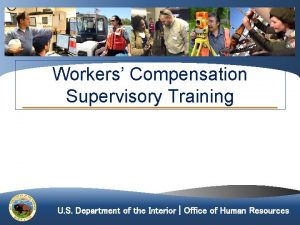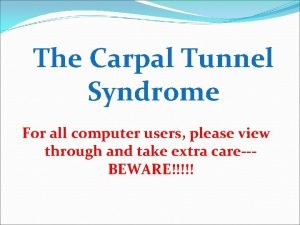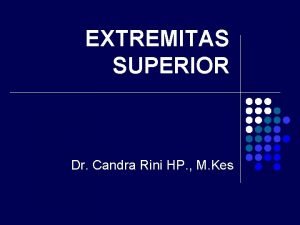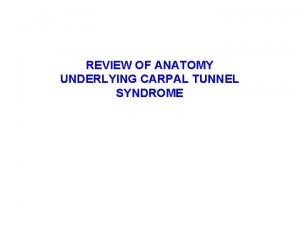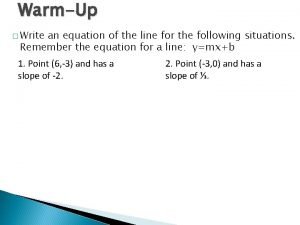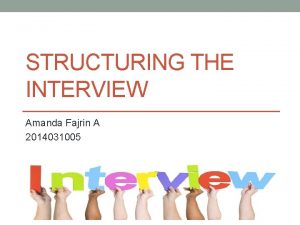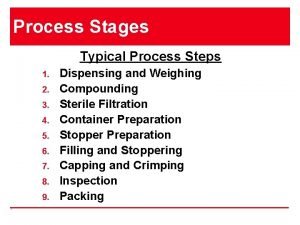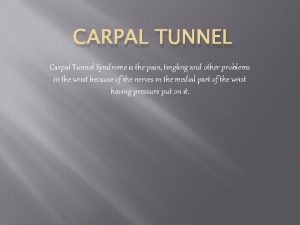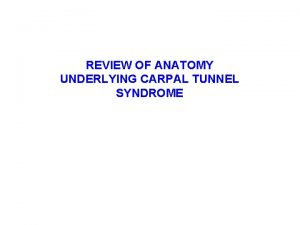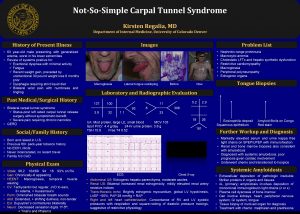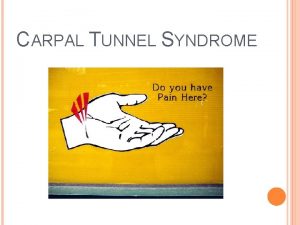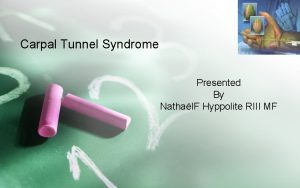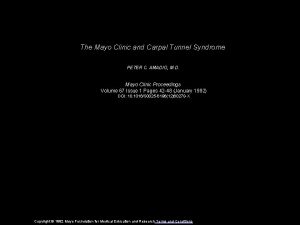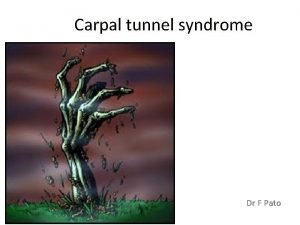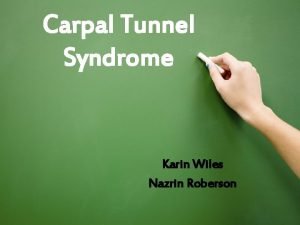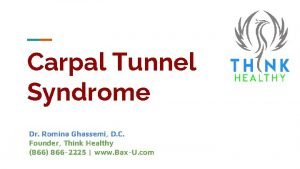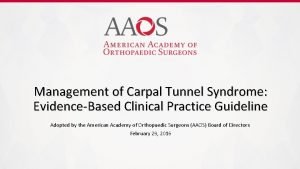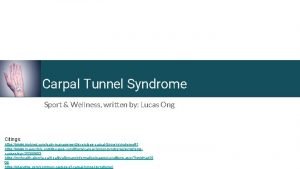Online Module Carpal Tunnel Syndrome Carpal Tunnel Syndrome



















- Slides: 19

Online Module: Carpal Tunnel Syndrome

Carpal Tunnel Syndrome (CTS) By far the most common entrapment neuropathy, especially of the upper extremity. n Caused by compression of the Median Nerve at the wrist by the Transverse Carpal Ligament. n “Classic” patient is a 40 -something y/o female complaining of dominant-hand weakness, clumsiness, or stiffness with nocturnal dysesthesias (waking up at night due to painful hand numbness). n

CTS statistics As many as 1 in 10 Americans will experience CTS at some point in their lives. n Female to Male ration = 4: 1 n More than 50% of patients with CTS have bilateral involvement, though symptoms are usually worse in dominant hand. n Associated with repetitive wrist/hand motions. n n Secretaries, computer use, writers, shop workers, etc.

CTS n It is important to have a high degree of suspicion for CTS because… if caught early, non-operative management is usually very successful in bringing patients relief. n If conservative management fails, surgical options carry a very high success rate and have low risk of complications. n Overall, patients should not have to suffer with undiagnosed CTS! n

CTS signs/symptoms Nocturnal dysesthesia: Patients will complain of waking up due to “painful numbness” of their hand. They will “shake it out, ” or run water over it, or rub hands together to try to relieve the symptoms. n Subjective complaints regularly include involvement of the underside of the forearm, and can even radiate proximal to the elbow! n Onset usually insidious, present for months. n

CTS signs/symptoms Complaints of hand weakness are common; may include “stiffness, ” “clumsiness, ” and difficulty with gripping/holding things in affected hand. n Pain, numbness, burning, loss of sensation in a median nerve-distribution of the palm. n n Subjective complaints involving any of the first three fingers carries an 80% sensitivity!!!

CTS signs/symptoms Most CTS complaints are secondary to sensation changes; even fine motor skill loss is usually more due to loss of sensation than motor weakness. n Muscle atrophy is classically appreciated in the “APB, ” Abductor Pollicis Brevis muscle, which provides bulk to thenar emenince. n n Muscle wasting, however, is a LATE finding of CTS. Therefore, just because a patient’s thenar eminence and/or motor exam is normal, does not r/o CTS!

Median Nerve Supply n A cool pneumonic to remember the palmar muscles that are innervated by the Median Nerve: Meat-LOAF Meat – Median nerve n L – lumbricals 1 and 2 n O – opponens pollicis n A – abductor pollicis brevis n F – flexor pollicis brevis n

Phalen’s Test Performed by maximally flexing the wrist; between 30 seconds to 1 minute of this will worsen or reproduce pain or tingling in 80% of cases of CTS. n It is POSITIVE if symptoms are worsened or reproduced. n n It is NEGATIVE, of course, if they are not.

Tinel’s Sign Test for by percussing over the carpal tunnel. n Tinel’s sign is PRESENT if paresthesias or pain in median nerve distribution are produced by this action. n n The sign is ABSENT if not.

CTS n In most cases, a diagnosis of CTS can be reasonably arrived at through a thorough history and physical exam. Even so, there are diagnostic tests which are used to help confirm the diagnosis and rule out other possible diagnoses.

EMG and NCV in CTS Electromyography (EMG) looks at the electrical activity of muscles, both at rest and during contraction. n EMG is abnormal in ~ 70% of cases of CTS. n Nerve Conduction Velocities (NCV) measure the speed and efficiency with which nerves are transmitting electrical signals. n NCV is abnormal in ~75 -85% of CTS cases. n

Differential Diagnoses that can mimic CTS Cervical radiculopathy n Thoracic Outlet Syndrome n Pronator Teres Syndrome n Reflex Sympathetic Dystrophy n Diabetic neuropathy n

Conditions that have been associated with CTS Multiple Myeloma n Rheumatoid Arthritis n Pregnancy n Amyloidosis n A/V dialysis shunts n Endocrine/Pituitary abnormalities n Hypothyroidism n acromegaly n

“Abnormal” CTS The presentation of CTS is usually fairly typical, in that it is with the previouslydescribed symptomology in a middle-aged or older adult who has a history of repetitive hand motions or some type of activity which can be associated with disturbing the median nerve at the wrist. n Occasionally, though, there are “odd” presentations of CTS which warrant further work-up. n

“Abnormal” CTS Young individuals, especially with no history of repetitive hand/wrist motions, should receive w/u including laboratory studies considering conditions associated with CTS (prev. slide). n “Acute” CTS – abrupt onset of CTS-like symptoms, usually after trauma or precipitating event. n Median artery thrombosis n TCL hematoma n

CTS treatment n Most cases of CTS can be adequately treated with conservative (i. e. non-surgical) management. Rest n NSAIDs, steroid injections n Neutral-position splints n n Surgical management is generally reserved for: CTS refractory to conservative management. n CTS with severe sensory loss and/or thenar atrophy. n

Surgical treatment of CTS Surgery for CTS involves either open or endoscopic approach with the same goal: surgical division of the Transverse Carpal Ligament. n Approximately 90% of surgically-treated patients report satisfactory results, with either improvement or resolution of symptoms of CTS. n n Complication rate ~ 2%

Summary n Carpal Tunnel Syndrome is a common, debilitating condition for which there is an excellent prognosis, provided that the condition is recognized and the patients receive appropriate attention and treatment.
 1152020
1152020 Assistive devices for carpal tunnel syndrome
Assistive devices for carpal tunnel syndrome Lateral cutaneous nerve of forearm
Lateral cutaneous nerve of forearm Owcp schedule award carpal tunnel
Owcp schedule award carpal tunnel Carpal tunnel release scar
Carpal tunnel release scar Ossae carpal
Ossae carpal Carpal kemikleri
Carpal kemikleri Carpal bones
Carpal bones Partes de la escapula
Partes de la escapula C device module module 1
C device module module 1 How to write the equation of a line
How to write the equation of a line Tunnel terminology
Tunnel terminology Hard rock
Hard rock Pre heat tunnel
Pre heat tunnel Anton anderson tunnel
Anton anderson tunnel Tunnel sequence interview
Tunnel sequence interview Typical process
Typical process Veit tunnelfinisher
Veit tunnelfinisher Disadvantage of drip irrigation
Disadvantage of drip irrigation Delphi vnc
Delphi vnc



